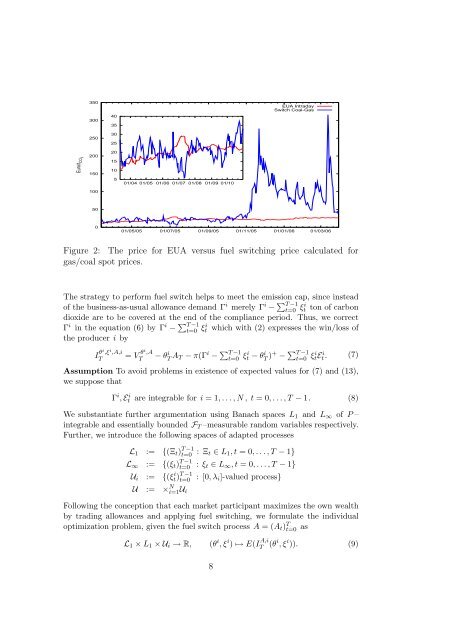A quantitative approach to carbon price risk modeling - CiteSeerX
A quantitative approach to carbon price risk modeling - CiteSeerX
A quantitative approach to carbon price risk modeling - CiteSeerX
Create successful ePaper yourself
Turn your PDF publications into a flip-book with our unique Google optimized e-Paper software.
350<br />
300<br />
250<br />
40<br />
35<br />
30<br />
25<br />
EUA Intraday<br />
Switch Coal-Gas<br />
Euro/t CO2<br />
200<br />
150<br />
20<br />
15<br />
10<br />
5<br />
01/04 01/05 01/06 01/07 01/08 01/09 01/10<br />
100<br />
50<br />
0<br />
01/05/05 01/07/05 01/09/05 01/11/05 01/01/06 01/03/06<br />
Figure 2: The <strong>price</strong> for EUA versus fuel switching <strong>price</strong> calculated for<br />
gas/coal spot <strong>price</strong>s.<br />
The strategy <strong>to</strong> perform fuel switch helps <strong>to</strong> meet the emission cap, since instead<br />
of the business-as-usual allowance demand Γ i merely Γ i − ∑ T −1<br />
t=0 ξi t <strong>to</strong>n of <strong>carbon</strong><br />
dioxide are <strong>to</strong> be covered at the end of the compliance period. Thus, we correct<br />
Γ i in the equation (6) by Γ i − ∑ T −1<br />
t=0 ξi t which with (2) expresses the win/loss of<br />
the producer i by<br />
I θi ,ξ i ,A,i<br />
T<br />
= V θi ,A<br />
T<br />
− θT i A T − π(Γ i − ∑ T −1<br />
t=0 ξi t − θT i )+ − ∑ T −1<br />
t=0 ξi tEt. i (7)<br />
Assumption To avoid problems in existence of expected values for (7) and (13),<br />
we suppose that<br />
Γ i , E i t are integrable for i = 1, . . . , N , t = 0, . . . , T − 1. (8)<br />
We substantiate further argumentation using Banach spaces L 1 and L ∞ of P –<br />
integrable and essentially bounded F T –measurable random variables respectively.<br />
Further, we introduce the following spaces of adapted processes<br />
L 1 := {(Ξ t ) T t=0 −1 t ∈ L 1 , t = 0, . . . , T − 1}<br />
L ∞ := {(ξ t ) T t=0 −1 t ∈ L ∞ , t = 0, . . . , T − 1}<br />
U i := {(ξt) i T t=0 −1 i]-valued process}<br />
U := × N i=1U i<br />
Following the conception that each market participant maximizes the own wealth<br />
by trading allowances and applying fuel switching, we formulate the individual<br />
optimization problem, given the fuel switch process A = (A t ) T t=0 as<br />
L 1 × L 1 × U i → R,<br />
(θ i , ξ i ) ↦→ E(I A,i<br />
T (θi , ξ i )). (9)<br />
8
















